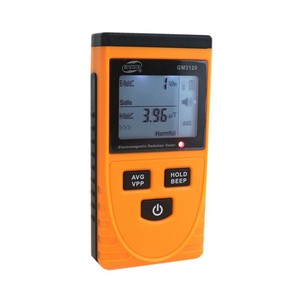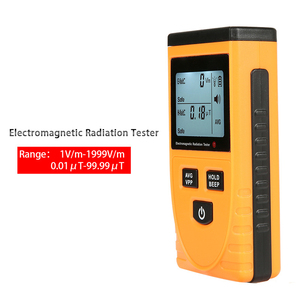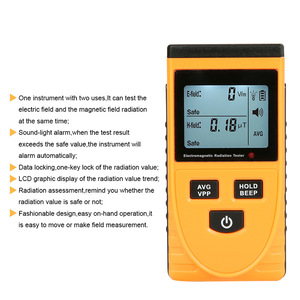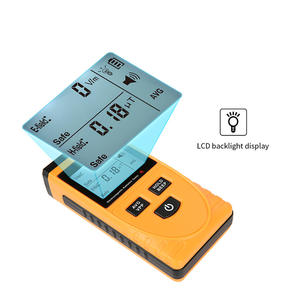(566 products available)



































































































































































































































This type uses digital technology, allowing for better accuracy and immediate reading. Digital Geiger counters typically showcase the radiation level on an LCD panel, facilitating simple interpretation. Certain versions can save and transmit data for advanced examination. Favorable sectors include research and healthcare, where precise and prompt readings are mandated.
A radiation detection and measurement device is purposed with identifying and quantifying various radiation types, such as gamma, beta, and alpha particles. Commonly integrated in nuclear power stations, defense, and space spheres, these devices secure exposure regulation and safety. Many of these instruments present detailed maps of radiation distribution for effective containment and shielding.
Survey meters assess environmental radiation levels, frequently employed in the field of nuclear energy. These portable meters allow quick checks, often to ensure safety in radiological areas or following an incident. They usually have both an audible and visible output of measurement to alert personnel promptly. Their durable design suits harsh outdoor environments.
Meter devices check surfaces for radioactive contamination, particularly in nuclear and medical industries. They assist workers in identifying tagged areas, thus reducing exposure to unhygienic environments. Such devices often have a probe to scan materials, producing instant readings. Many also possess alarms that trigger when contamination surpasses predetermined thresholds.
Geiger counters comprise various elements, including a Geiger-Muller tube, which detects radiation. This tube typically features metal and glass; the interior is filled with gas to enable ionization. The count is commonly housed in a sturdy shell, often in plastic or aluminum, which safeguards the internal components while resisting hostile environments.
Apart from the detector tube, other elements include scintillator materials like sodium iodide or plastic scintillator for scintillation counters. These materials convert radiation into light, which photomultiplier tubes or sensors capture. The counters also include circuit boards fabricated from fiberglass-reinforced plastic, ensuring toughness and functional reliability for extended periods.
The housing of the Geiger meter constitutes durable materials, typically sturdy plastic or metals like aluminum. These materials are identified to bolster housing lifespan by shielding the sensitive internal components from potential environmental threats. Durable housing is especially crucial in industries like nuclear facilities or emergency situations, where the device may be exposed to critical temperatures or hazardous conditions.
Several Geiger counters also flaunt waterproof or IP-rated designs that safeguard against moisture, dust, and debris entry. This rating proves valuable for outdoor usage or settings subject to moisture or particulate levels. Proper housing increases device longevity, ensuring it remains useful in varied operating conditions.
Geiger counters are instrumental in industries relating to nuclear facilities. They are integral to monitoring radiation levels, assuring employee safety, and sustaining optimal operational practices. These devices are vital in detecting leaks and averting uncontrolled exposure by performing regular checks in standard and emergency scenarios.
The devices also find applications in the manufacturing realm, inspecting materials for radiation before and post-processing. This ensures raw materials integrated into production processes meet safety standards. When applied, radioactive material detectors mitigate potential contamination risks, protecting both products and workforce health and safety.
In research laboratories, Geiger counters are employed to measure and monitor radiation levels in experiments and procedures. They guarantee that the levels remain within set safety limits. In fields like environmental science, these devices measure radiation in diverse ecosystems, aiding research on its impacts on flora, fauna, and humans.
Moreover, medical facilities utilize Geiger counters to monitor radioactive substances in treatment and diagnostic procedures like radiation therapy. They guarantee emission compliance with safety standards, minimizing patient and staff exposure. In waste disposal, these counters are critical in identifying and classifying radioactive waste before disposal or recycling.
When selecting a Geiger counter, it is necessary to ensure one has the required sensitivity for the anticipated radiation types, such as alpha, beta, or gamma. This is key to guaranteeing effective detection. Assessing the device's response time is equally important in environments where rapid readings are crucial for safety decision-making.
Measuring range capability is another consideration. It should accommodate the lowest to the highest radiation levels expected in the targeted operational space. Finally, ascertain the readout and indicators; a digital display with audible alarms can enhance usability, especially in low-light or high-stress environments.
It is also essential to consider the application context. For users in nuclear power plants or hazardous waste disposal, counters with robust housing and dependable waterproofing are practical under hostile environmental circumstances. Meanwhile, fieldworkers might prioritize lightweight and portable designs for ease and quick access.
The historical reliance of emergency services and military personnel on a counter's accuracy demands verification through third-party testing or certification. Selecting one that meets strict safety and effectiveness standards ensures reliability in high-stakes situations. Moreover, consider ease of use, data storage, and transmission capabilities to enhance operational efficiencies in the counter selected.
A1: A counter's core components include a Geiger-Muller tube, scintillator, and photomultiplier tube. The Geiger-Muller tube ionizes gas within, counting ionized particles to detect radiation. Scintillators transform radiation into light, while photomultipliers amplify this light for measurement. These components may vary based on the type of counter, such as an ion chamber or scintillation counter, impacting performance and application suitability.
A2: These devices are widely used in the nuclear, medical, research, construction, and environmental fields. They measure radiation levels in nuclear plants, monitor radioactive materials in medical treatments, and track contamination in construction sites. In research laboratories, they investigate radiation effects, while environmental agencies assess ecosystem pollution. Their versatility secures a wide-ranging application in ensuring safety and compliance with regulations.
A3: Their accuracy hinges on the calibration level, detector type, and operating conditions. Calibrating a counter against known radiation sources ensures it renders precise readings. The detector type, such as the Geiger-Muller tube or scintillation detector, affects its range and sensitivity. Additionally, environmental factors, including temperature and humidity, influence performance. Proper maintenance and routine recalibration maintain long-term accuracy, especially in dynamic environments.
A4: These counters boast diverse user-friendly features. Live LCD screens exhibit real-time radiation levels, while audible alarms signal threshold exceedance. Data logging capabilities capture historical radiation levels for assessment. In contrast, rugged, portable designs, some equipped with Bluetooth for external device pairing, improve field usability. Such enhancements simplify operations and enrich situational awareness in demanding environments.
A5: Yes, these counters are intended to function in harsh conditions. They possess durable exteriors that resist extreme temperatures, moisture, and dust, endorsing reliable performance in outdoor and industrial settings. Materials like aluminum and reinforced plastic safeguard internal components from damage. IP ratings confirm their defense against water and particulate ingress, ensuring protection in risky scenarios.